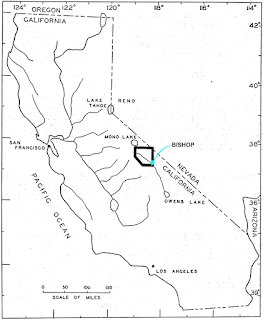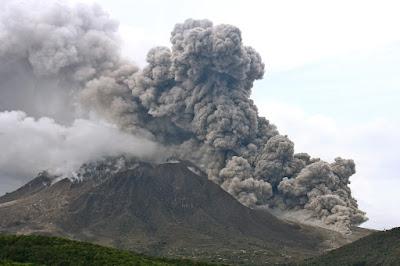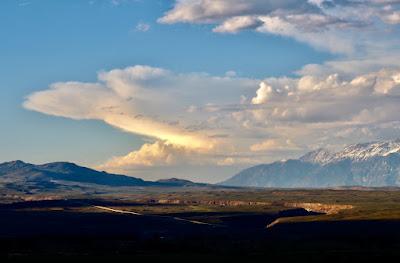 Last May on the way home from the West Coast, we stopped below the steep east face of the Sierra Nevada. From the campsite I looked out across the broad Volcanic Tableland, and saw a winding incision rimmed in rhyolite glowing in the evening light. It was the Owens River Gorge, the next day's destination where we would "experience" an ancient cataclysm. Geology is wonderful that way!
Last May on the way home from the West Coast, we stopped below the steep east face of the Sierra Nevada. From the campsite I looked out across the broad Volcanic Tableland, and saw a winding incision rimmed in rhyolite glowing in the evening light. It was the Owens River Gorge, the next day's destination where we would "experience" an ancient cataclysm. Geology is wonderful that way! The Volcanic Tableland lies just north of Bishop, California. It's about 350 square miles in extent, and as much as 750 feet thick—a humongous block of rock called the Bishop tuff. It was named in 1938 by a geology grad student from the University of California Berkeley—Charles M. Gilbert. "Since the formation covers an extensive area, has characters unique in the region, and represents a definite part of the Pleistocene epoch, the name Bishop tuff is suggested as a fitting designation, after the chief town in the vicinity."
The Volcanic Tableland lies just north of Bishop, California. It's about 350 square miles in extent, and as much as 750 feet thick—a humongous block of rock called the Bishop tuff. It was named in 1938 by a geology grad student from the University of California Berkeley—Charles M. Gilbert. "Since the formation covers an extensive area, has characters unique in the region, and represents a definite part of the Pleistocene epoch, the name Bishop tuff is suggested as a fitting designation, after the chief town in the vicinity."
Gilbert's study area; town of Bishop added, location approximate.
Tuff forms from volcanic ejecta, mainly ash, blown out in explosive eruptions and then lithified (turned to rock) after deposition. Ash may stay airborne and travel great distances before forming fallout deposits. The alternative is much more deadly. The eruption column can collapse, sending hot incandescent ash flows racing across the landscape, searing everything in their path.Gilbert spent three field seasons studying the Bishop tuff. He examined and sampled it at multiple depths in the Owens River Gorge, and across its extent from Bishop north to a few miles south of Mono Lake (in a tunnel being dug for the Los Angeles Aqueduct). Everywhere he went, he found the tuff to be rhyolitic (a common type, high in silica).
In fact the Bishop tuff was surprisingly uniform in composition, given its extent. However texture varied with depth—an important clue as to origin: "the tuff, soft and porous at the top, becomes gradually less porous and harder toward the base ..." Gilbert also noted that the soft uppermost tuff did not ring with the blow of a hammer, "in marked contrast" with hardened tuff below.
Back in the lab, microscopic examination of tuff samples revealed that ash and other fragments were welded together, increasingly so with depth. Gradation was continuous, and distortion had taken place without fracturing. Gilbert concluded the cause was "vertical compression by the weight of the deposit after its emplacement." And judging by the extensive welding, the deposit must have been extremely hot. There was but one possible perpetrator—a nuée ardente.
Nuée ardente or pyroclastic flow, Soufriere Hills, Montserrat; Nov 2010 (USGS).
"The nuées ardentes (burning or glowing clouds) remain, then, as the agent which probably emplaced the Bishop tuff. The nuées are flows of intensely hot, discrete fragments of viscous magma, in which each fragment rapidly and continuously emits its gases. The fragments are thus enveloped and cushioned by extremely dense, hot gas, and the whole has the appearance of a dense, rapidly expanding 'cloud'. Such a cloud rolls rapidly over even a gentle slope ... [leaving] hot pyroclastic material which may mantle the surface over an extensive area and which retains its heat and continues to emit hot gases for long periods of time. Only by some such agent can the emplacement and features of the Bishop tuff be explained." (Gilbert 1938, emphasis mine)At the time of Gilbert's publication, the idea that welded tuffs were products of nuée ardentes was not widely accepted. In his Introduction, he explained that "the author hopes that the description of one of them given in this paper will help in the recognition of others which may be found and also contribute toward a better understanding of their origin." That hope has been realized! The Bishop tuff is world famous, a geological mecca of sorts.

Today's geologists agree.
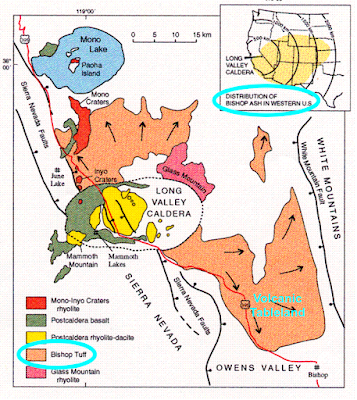
The Long Valley Caldera produced the Bishop tuff (orange). Inset shows ashfall deposits as far east as Nebraska and Kansas—1000+ miles. USGS (highlights added).
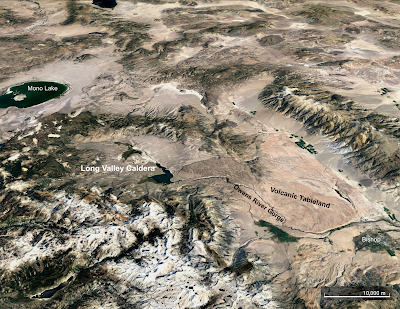
The Owens River flows from Lake Crowley (reservoir) in the former Long Valley Caldera and crosses the Volcanic Tableland via the Owens River Gorge. Google Earth 2019.
In the nearly 90 years since Gilbert's study, much has been learned about the Volcanic Tableland and Bishop tuff. They formed just 760,000 years ago (geologically young) during a series of eruptions in the area of today's Long Valley, as Gilbert suspected. It must have been spectacular!! In less than a week the vents disgorged 150 cubic miles of tuff—equal to the volume of Mt. Shasta and far more than any eruption in recorded history.During this massive outpouring the ceiling of the magma chamber collapsed, creating an elliptical depression about 10 x 20 miles in extent—the Long Valley Caldera. Continuing eruption filled much of it, but not all.

For some 600,000 years post-eruption, water and sediment running off the Sierra Nevada ponded in the Long Valley Caldera. Then about 100,000 years ago, perhaps during a cool wet glacial interval, the lake breached the caldera rim on the southeast side and today's Owens River was born. What it did from there is unclear.
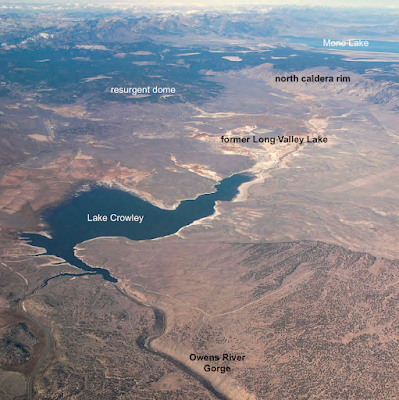
Lake Crowley in Long Valley; pale deposits upstream are from former Long Valley Lake. (Hildreth & Fierstein 2016, labels added).
Streamflow may have been vigorous enough to downcut rapidly through the relatively soft Bishop tuff (Sharp & Glazner 1993/2002). But meanders in the gorge suggest the Owens River was first a shallow winding stream. Perhaps with subsequent rising and tilting of the land (this area is tectonically active), the river downcut more rapidly but was constrained by established meanders (Hildreth & Fierstein 2016, 2017).Whatever the scenario, the Owens River has incised a deep narrow gorge that exposes the innards of the Volcanic Tableland. Let's go have a look.
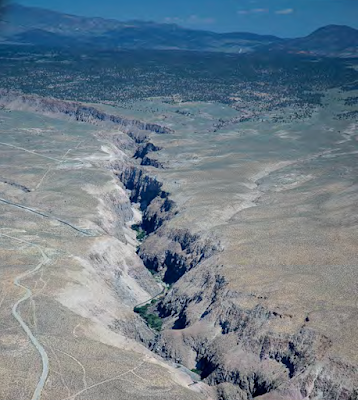
Owens River Gorge looking north; note meanders (Hildreth & Fierstein 2016).

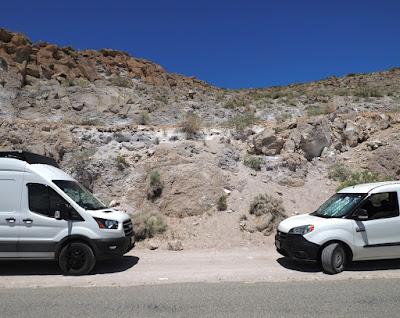
Ways & Means (mine on right).
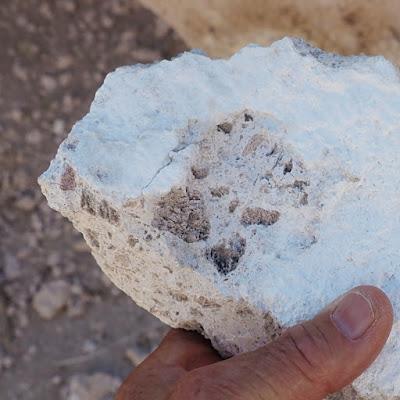
Pinkish-gray blobs are pumice fragments.
The rock at the parking area was extremely porous due to remains of tiny bubbles from the explosive eruption, and contained many randomly scattered fragments of pumice. It was surprisingly light, almost airy. With tuff in hand, I read the guidebook's horrific account of this place 760,000 years ago, when a searing racing cloud of molten magma fragments and volcanic gases exploded out of the Long Valley Caldera and came to rest here. Initially it was hot (1500º F!), plastic, and porous throughout. But that changed as the deposit cooled.As we descended through the pyroclastic flow, the tuff became more dense, and pumice fragments more deformed. I matched rocks with guidebook descriptions while my field assistant waited in bits of shade. And I thought of CM Gilbert in whose footsteps we walked, wishing there were some way to tell him of the many geologists who pass this way every year, awestruck by the Bishop tuff.
Not far from the parking area, the tuff was denser but pumice fragments still obvious. There were many irregular holes where fragments had fallen out. There also was a line of perfectly round holes—relics of paleomagnetic studies critical in developing plate tectonics theory in the 1960s.
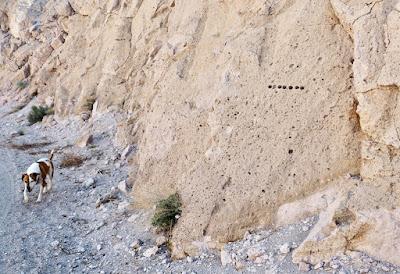
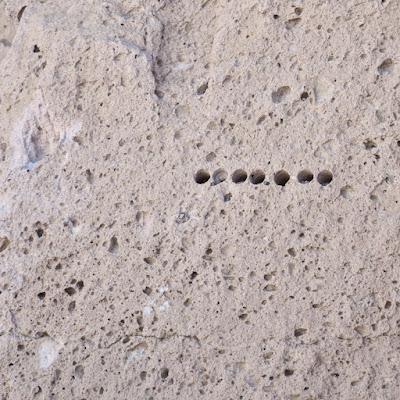
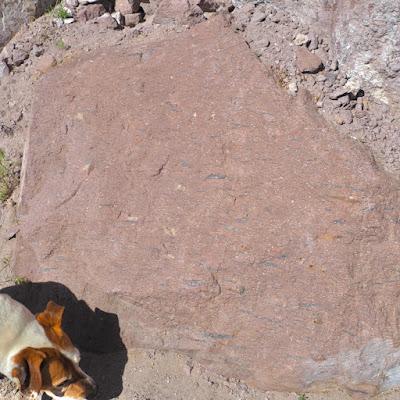
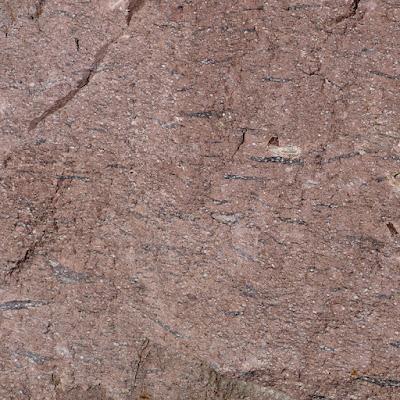
Pink tuff with elongate blackish pumice fragments.
At a really obvious color change, we entered full-on welded tuff. It was uniformly dark gray and no pumice fragments were visible; they had been severely deformed and even remelted under that great burden of extremely hot volcanic debris. I lifted a chunk—it was much denser and heavier than the piece I hefted at the parking area.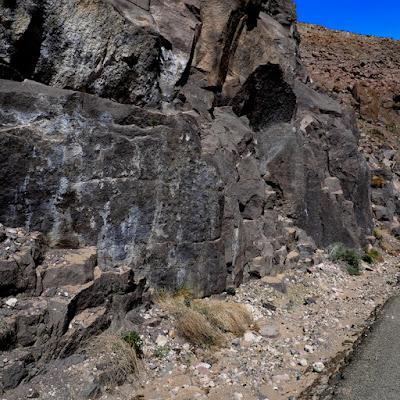
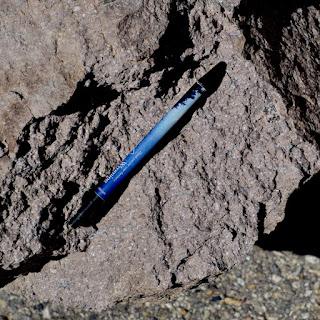
My camera's meter struggles with dark rock in bright sun.
Then we turned around and walked back up the road.
Tuff recapitulation going up: dark gray to pink to almost white; welded and dense to porous and light.
Back at the top I looked across the Gorge and contemplated the spectacular columnar jointing, formed when the tuff shrank and cracked with cooling. The upper columns were slender and well-defined. Those below, which formed in slower-cooling densely-welded tuff, were larger and barely columnar, almost amorphous.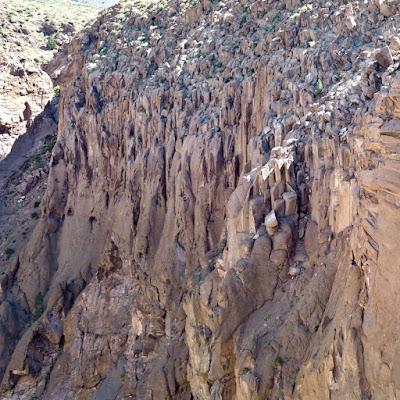
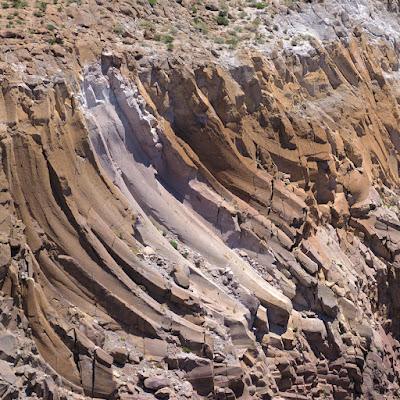
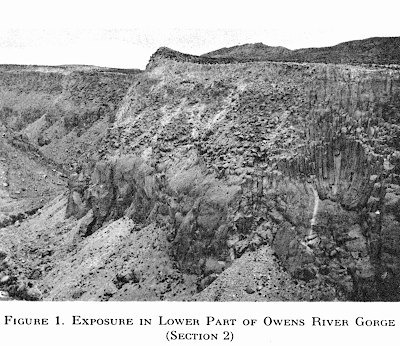
Note curving columns center right; from Gilbert 1938.
I was thrilled when I realized that the photo in Gilbert's paper was taken very close to where I parked. In fact, it's a popular shot.
The Smithsonian's Global Volcanism website includes the same curved columns in the Bishop tuff.
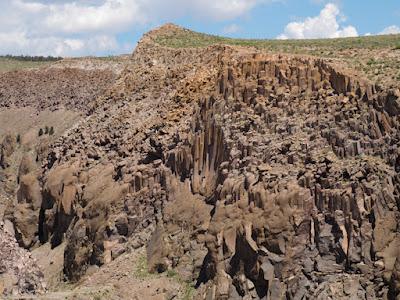
My photo—a rock flower born of fire and water.
These odd arrangements of columns curving down to a common point have been called joint rosettes or rock tulips. They're attributed to fumaroles (vents through the tuff) that released volcanic gases enhanced with steam, perhaps where the pyroclastic flow overran and vaporized the ancestral Owens River. Indeed there are many fossil fumaroles on the Volcanic Tableland in the vicinity of the Gorge.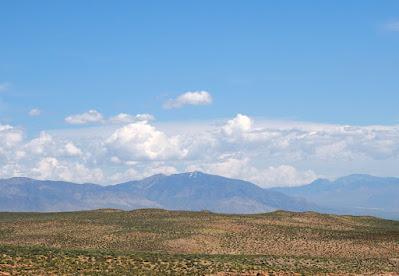
Bumps on the Volcanic Tableland are fossil fumaroles, typically 10–20 feet tall.
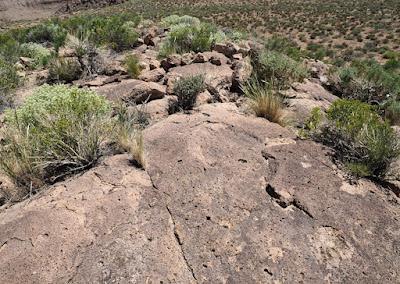
Atop a fossil fumarole. Tuff cemented with minerals from volcanic gases is more resistant to erosion.
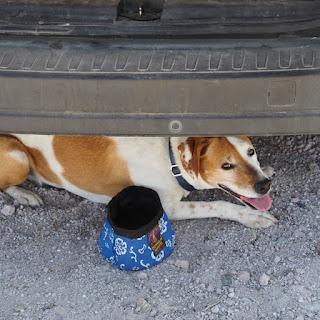
Relaxing after a hot but fascinating day in the field.

Sources
Gilbert, CM. 1938. Welded tuff in eastern California: GSA Bull. 49:1829–1862.
Hay, RL. 1989? Memorial to Charles M. Gilbert, 1910-1988. GSA PDF
Hildreth, W, and Fierstein, J. 2016. Long Valley Caldera Lake and reincision of Owens River Gorge. USGS Sci. Inv. Rep. 2016–5120. https://doi.org/10.3133/sir20165120
Hildreth, W, and Fierstein, J. 2017. Geologic field-trip guide to Long Valley Caldera, California. USGS Sci. Inv. Rep. 2017–5022–L. https://doi.org/10.3133/sir20175120L
Sharp, RP, and Glazner, AF. 1993 (2002). Geology Underfoot in Southern California. Mountain Press Publ.
USGS, California Volcano Observatory. Long Valley Caldera.
